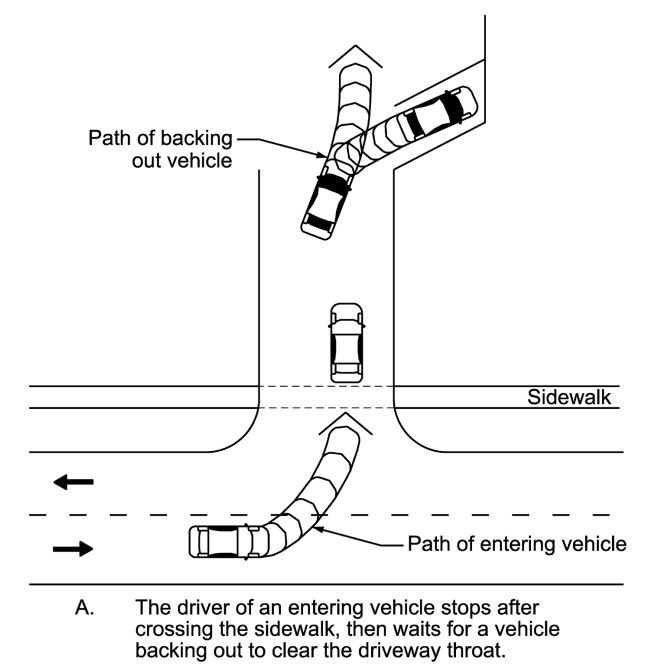19.5.1 General Guidelines
Accommodating pedestrians and vehicular traffic at the junctions of sidewalks and driveways presents a variety of challenges. Some general principles are:
- Consider using right-turn deceleration/storage lanes so that right-turning drivers can safely wait in the auxiliary lane, clear of through traffic, while pedestrians are present in, or near, the driveway (see ). Queuing length should meet the needs of the design vehicle. In locations where a driveway functions as an intersection, pedestrian safety features should be included. These features may include crosswalks, small corner radii to limit turning speeds to 10 mph, and pedestrian signal heads (if signalized) as warranted.
- Detectable warnings should not be provided where minor driveways cross a sidewalk. However, if the driveway is controlled with a traffic signal or a stop sign, detectable warnings are required.
- Where separator islands are provided between inbound and outbound travel lanes in a driveway, the island must provide a pedestrian refuge with a minimum width of 6-ft. See for the design of pedestrian refuge islands. depicts a separator island.
- Driveways must maintain the PAR as a continuous, ADA compliant grade, and clearly delineated path to encourage drivers to stop and yield to pedestrians. For example, if the sidewalk is composed of concrete and it is crossing an asphalt driveway, the concrete should be continuous across the driveway. The PAR within the driveway crossing must meet accessibility standards (see ).
- Locate sidewalks far enough from the curb, or edge of pavement (4-ft or greater is preferred), to provide a suitable transition between the pavement cross-slope and the driveway apron and to allow the driveway to cross the sidewalk at the same elevation as the approaching sidewalk.
- Where driveways are closely spaced, consider the use of right-in/right-out driveways to eliminate conflicts between left-turning vehicles and pedestrians. In this case it is recommended that provisions be made for the left-turns only at locations where the vehicular-pedestrian conflict can be safely addressed by appropriate design and traffic control.
- TxDOT may work with local jurisdictions to ensure throat length allows for enough space for vehicles to queue out of the path of pedestrian travel (see ). Vehicles should not block the sidewalk when parked in driveway.

Figure 19-17: Channelizing Island Provide Pedestrian Refuge

Figure 19-18: Sufficient Throat Length Should Allow Entering Vehicle to Clear the Through Traffic Lane.